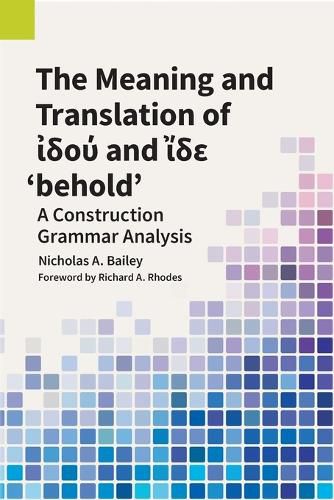Readings Newsletter
Become a Readings Member to make your shopping experience even easier.
Sign in or sign up for free!
You’re not far away from qualifying for FREE standard shipping within Australia
You’ve qualified for FREE standard shipping within Australia
The cart is loading…






This title is printed to order. This book may have been self-published. If so, we cannot guarantee the quality of the content. In the main most books will have gone through the editing process however some may not. We therefore suggest that you be aware of this before ordering this book. If in doubt check either the author or publisher’s details as we are unable to accept any returns unless they are faulty. Please contact us if you have any questions.
The Koine Greek particles ???? and ??? have been traditionally translated as either 'behold' or 'lo'. But such mechanical renderings are inadequate as they suggest these particles can be reduced to a single meaning or function. As argued in this monograph, these particles actually have several distinct uses that are conditioned by their linguistic context, and a translator should find natural idioms in the receptor language that match the meaning and function of these Greek uses.
Based on a Construction Grammar approach, Bailey's analysis of all 200 New Testament instances of ???? and 29 instances of ???, as well as many from the LXX and extra-biblical materials, differentiates at least five uses. Examples of suitable and unsuitable renderings of the five uses are illustrated from 31 published translations in English and other European languages. The differences in the five uses are reflected most clearly in their functional differences in deixis and information structure. Although the analysis draws on insights from the theories of Construction Grammar and Cognitive Linguistics, familiarity with these theories is unnecessary to benefit from the study. This analysis also serves as a major refinement of the entries of these particles in the standard lexicon, BDAG.
Biblical studies scholars, exegetes, Bible translators, students of Koine and Ancient Greek, linguists interested in functional and typological linguistics, pastors, and others will benefit from reading this analysis and following the example of its analytical approach with other elements of the language.
$9.00 standard shipping within Australia
FREE standard shipping within Australia for orders over $100.00
Express & International shipping calculated at checkout
This title is printed to order. This book may have been self-published. If so, we cannot guarantee the quality of the content. In the main most books will have gone through the editing process however some may not. We therefore suggest that you be aware of this before ordering this book. If in doubt check either the author or publisher’s details as we are unable to accept any returns unless they are faulty. Please contact us if you have any questions.
The Koine Greek particles ???? and ??? have been traditionally translated as either 'behold' or 'lo'. But such mechanical renderings are inadequate as they suggest these particles can be reduced to a single meaning or function. As argued in this monograph, these particles actually have several distinct uses that are conditioned by their linguistic context, and a translator should find natural idioms in the receptor language that match the meaning and function of these Greek uses.
Based on a Construction Grammar approach, Bailey's analysis of all 200 New Testament instances of ???? and 29 instances of ???, as well as many from the LXX and extra-biblical materials, differentiates at least five uses. Examples of suitable and unsuitable renderings of the five uses are illustrated from 31 published translations in English and other European languages. The differences in the five uses are reflected most clearly in their functional differences in deixis and information structure. Although the analysis draws on insights from the theories of Construction Grammar and Cognitive Linguistics, familiarity with these theories is unnecessary to benefit from the study. This analysis also serves as a major refinement of the entries of these particles in the standard lexicon, BDAG.
Biblical studies scholars, exegetes, Bible translators, students of Koine and Ancient Greek, linguists interested in functional and typological linguistics, pastors, and others will benefit from reading this analysis and following the example of its analytical approach with other elements of the language.